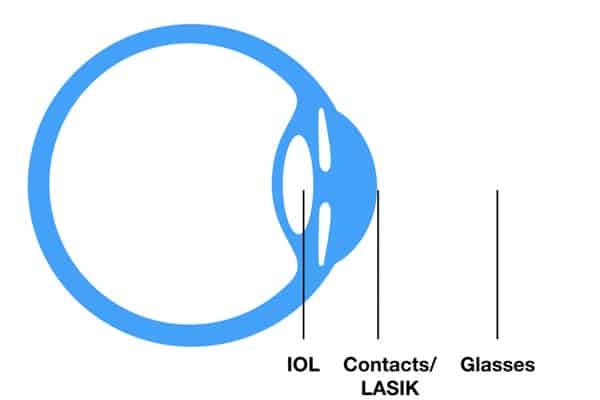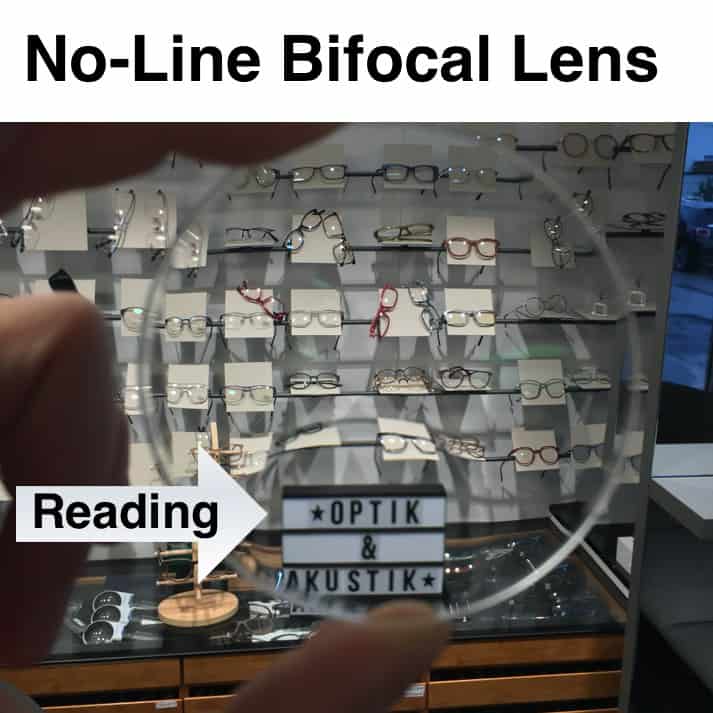If you are looking for alternatives to progressive lenses you probably know about the disadvantages like blurry peripheral vision or the process of getting used to them and want to avoid all that. What could you buy to get the ability back to read at close distances?
- TouchFocus get the reading power by swiping the temple
- Clip-on glasses with different prescriptions
- Ortho K Multifocal Contact Lenses
- Laser Blended Vision (LASIK for presbyopia)
- Intraocular multifocal lenses (IOLs)
- No-Line Bifocals
Touchfocus the Newest Alternative for Progressive Lenses
One alternative for progressive glasses that will amaze you is Touchfocus. It has a liquid crystal lens build in which can be toggled on or off by swiping the temple. It is powered by a replaceable nickel-metal hybrid battery that can be charged more than 500 times. The interesting part about this is the dimensions of the near field. It is 20mm wide and has a height of 13mm. That means it is comparable to a bifocal lens design regarding the reading field.
Currently, TouchFocus is only available in Japan. You get this alternative for your progressive lenses just in the local partner stores. The company has a collection of seven frames and different colors. As Touchfocus said it takes almost no time to switch the near field on. That is really powerful because you do not have distortions in your peripheral vision that blurs your vision in the lower half as you walk stairs for example. The video below is in Japanese but you will get the point of how to touch focus works.
The price for this alternative to progressive lenses is 2000 – 2500€. It is individually manufactured to your prescription. To learn more about this exciting product visit their home page. (But you should be able to read Japanese). The battery should last all day in normal use.
Clip-On Glasses With Different Prescriptions for Far Intermediate and Near Vision
The second alternative for progressive lenses is less high tech but will deliver you a bigger field of view. One drawback with the first alternative is as you work with a normal desktop PC Screen you tend to tip your head back. Only then you can use the support for near vision. Because in the upper half there is no liquid crystal field to sharpen your vision in the near distance.

If you totally do not want to compromise your posture while working with your PC all day long and you do not want to have a second pair of glasses may be clipping on you near prescription would be an option for you. The way this works is a simple magnet clip-on that holds the reading power. It works best if you work long hours in one distance.
With such a clip system you could have multiple clip-ons with different powers dedicated to close range reading the mid-distance or just a clip-on for sunglasses. Some of our customers really love this solution. Compared to trifocals, bifocals, or progressive lenses the field of view is just as big as it can get. There is no need for you to point your nose in the direction you want to see sharp in.
Obviously, you need to have your clip-ons always with you to get the support out of it and it takes a second more to clip them on. Compared to a simple swipe on the temple as with the touchfocus glasses.
Ortho K Multifocal Contact lenses
Ortho K lenses are worn only at night and during the day you do not need glasses or contacts. That is an amazing way to correct farsightedness, astigmatism, myopia, and of course presbyopia. On day time you do not need to blink as many times because you do not have anything on your eyes that dries up over time compared to normal contact lenses.

If you want to have the freedom of being able to readjust the prescription as you need it and you don´t want to get a LASIK treatment this is the way to go. A really big advantage over the LASIK is you can experience how your vision will change as multiple prescriptions are on your cornea at the same time. What usually happens is at night you experience a slightly blurred vision and the headlights of cars could be a little bit more stressful.
The changes made by these contacts are reversible. And I really like that compared to a LASIK. I personally have really great experience with myope clients that underwent multifocal ortho k treatment. There are several designs out there. But what the lens does is a reshaping of your eyes at night to sharpen your vision for the day. Every night you put them in. As long as you use them you will have a great vision all day. But as soon as you stop wearing them your prescription will go back to normal in a 48 hours time window.
Laser Blended Vision (LASIK for Presbyopia)
If you do not like to spend your time dealing with contact lens care or shopping for frames you could also consider Laser Blended Vision. Laser blended vision is a way to get a laser treatment that will give you back the power to focus on near-range objects.
Usually, those treatments can extend the time until you need a pair of glasses but it can be a good solution. One thing is clear though. As you get multiple corrections on a tiny space like your cornea you might lose a little contrast or clarity. Especially if you need an ADD higher than +1,50D to read.
The results are similar to multifocal lenses or Ortho K lenses. But you do not need to handle the care. If everything turns out as you like of course that is perfect for you. If not the process is not reversible. So I would first recommend to try out the other options as they are reversible.
Intraocular Multifocal Lenses (IOLs)
If you are over 65 you probably noticed a decline in your visual acuity compared to 30 years ago. The reason therefore is in your eye´s lens the material changes and could lead to cataract surgery. When doing cataract surgery you can decide which kind of lens model you choose. Most people go with a single vision lens for best far or near vision. But if you want both at the same time you could go with multifocal ones too.

This field is advancing forward but it has similar Problems compared to Ortho K, and other surgeries for presbyopia. You can get an overview of available lens designs here. As soon as far and near prescription is placed on such a tiny surface glare and halo effects just go with it.
But if you want to go with this alternative you will be probably very happy in bright light. Oftentimes with a less bright light around you, there is more need for an additional pair of glasses. But you should consider the options with your doctor.
No-Line Bifocals – One of the Lesser-Known Alternatives for Progressive Lenses
There are actually bifocal lenses that provide you with a really big field of view for reading and distance vision without a visible line. If progressive lenses did not work this can be a good alternative because of the sheer size of the fields. But there is also something to mention here.
As soon as you split the transition up into two separate fields without the smooth transition from far to near there is a high chance of you having a blurry gap in the mid-distance of around 80cm. The reason is, of course, the missing accommodation to that distance of your eyes.

The distance field has not enough power for focusing on that distance and if you are switching to the near field it is good for reading only but too strong for that mid-distance. The solution would be to increase or decrease the distance to the object you want to see sharp. The extremely short transition line is visible to you but not to a person in front of you. And it always comes with distortions in this little line of transitions. You can spot it in the picture above.
So this is my list of alternatives if progressive lenses are not your way to go. I hope you´ve got some new insights. I wish you a great day.

